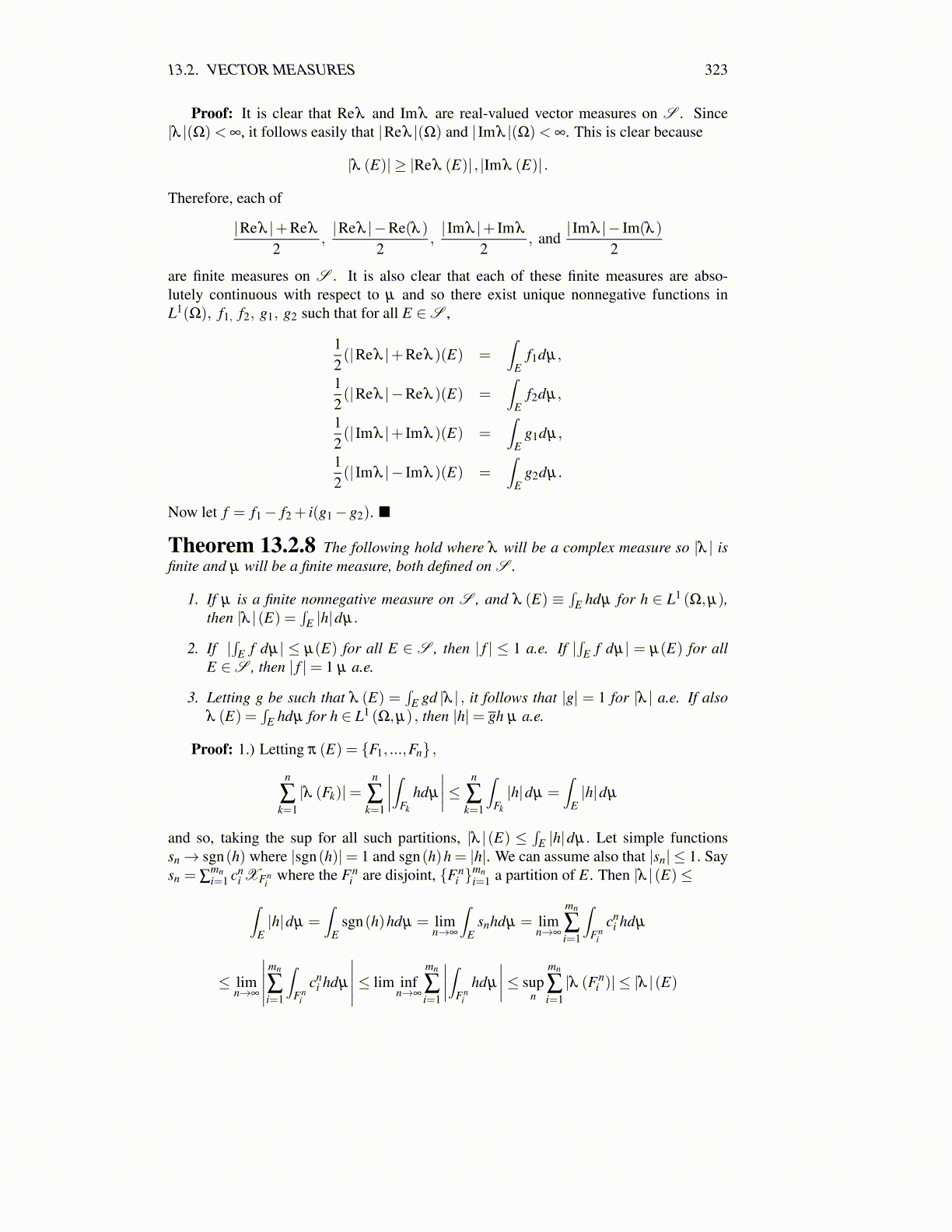
13.2. VECTOR MEASURES 323
Proof: It is clear that Reλ and Imλ are real-valued vector measures on S . Since|λ |(Ω)< ∞, it follows easily that |Reλ |(Ω) and | Imλ |(Ω)< ∞. This is clear because
|λ (E)| ≥ |Reλ (E)| , |Imλ (E)| .
Therefore, each of
|Reλ |+Reλ
2,|Reλ |−Re(λ )
2,| Imλ |+ Imλ
2, and
| Imλ |− Im(λ )
2
are finite measures on S . It is also clear that each of these finite measures are abso-lutely continuous with respect to µ and so there exist unique nonnegative functions inL1(Ω), f1, f2, g1, g2 such that for all E ∈S ,
12(|Reλ |+Reλ )(E) =
∫E
f1dµ,
12(|Reλ |−Reλ )(E) =
∫E
f2dµ,
12(| Imλ |+ Imλ )(E) =
∫E
g1dµ,
12(| Imλ |− Imλ )(E) =
∫E
g2dµ.
Now let f = f1− f2 + i(g1−g2). ■
Theorem 13.2.8 The following hold where λ will be a complex measure so |λ | isfinite and µ will be a finite measure, both defined on S .
1. If µ is a finite nonnegative measure on S , and λ (E) ≡∫
E hdµ for h ∈ L1 (Ω,µ),then |λ |(E) =
∫E |h|dµ.
2. If |∫
E f dµ| ≤ µ(E) for all E ∈ S , then | f | ≤ 1 a.e. If |∫
E f dµ| = µ(E) for allE ∈S , then | f |= 1 µ a.e.
3. Letting g be such that λ (E) =∫
E gd |λ | , it follows that |g| = 1 for |λ | a.e. If alsoλ (E) =
∫E hdµ for h ∈ L1 (Ω,µ) , then |h|= gh µ a.e.
Proof: 1.) Letting π (E) = {F1, ...,Fn} ,n
∑k=1|λ (Fk)|=
n
∑k=1
∣∣∣∣∫Fk
hdµ
∣∣∣∣≤ n
∑k=1
∫Fk
|h|dµ =∫
E|h|dµ
and so, taking the sup for all such partitions, |λ |(E) ≤∫
E |h|dµ. Let simple functionssn→ sgn(h) where |sgn(h)|= 1 and sgn(h)h = |h|. We can assume also that |sn| ≤ 1. Saysn = ∑
mni=1 cn
i XFni
where the Fni are disjoint, {Fn
i }mni=1 a partition of E. Then |λ |(E)≤
∫E|h|dµ =
∫E
sgn(h)hdµ = limn→∞
∫E
snhdµ = limn→∞
mn
∑i=1
∫Fn
i
cni hdµ
≤ limn→∞
∣∣∣∣∣mn
∑i=1
∫Fn
i
cni hdµ
∣∣∣∣∣≤ lim infn→∞
mn
∑i=1
∣∣∣∣∫Fni
hdµ
∣∣∣∣≤ supn
mn
∑i=1|λ (Fn
i )| ≤ |λ |(E)